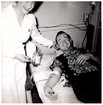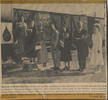
WP 106 History
FRRS Archives, Sue Swanton Collection
As the Korean War escalated, the Western Pacific Railroad considered ideas to support the troops overseas. An idea is proposed, often credited to WP's innovative PR director Gilbert Kneiss, to work with the Red Cross to equip a passenger car as a rolling blood collection center.
The concept of a large, long distance traveling blood collection center, let alone one that was a railroad car, was an idea that had never been tried. Previous blood collection centers were all in urban areas and the bloodmobiles attached to them stayed in very close proximity, less than 75 miles. The Blood Procurement Car would eventually, in some cases, see its collected blood travel over 1,300 miles to a processing center.
To create its blood procurement car, the Western Pacific chose Eastern Division Superintendent's Car 106, a Pullman executive observation car. The 106 had been built by Pullman in September 1917 as part of a set of three cars: the Patriot, the Pilgrim and the Pioneer, which was the future 106. All three were used in Pullman's lease fleet, a steam era version of an executive jet timeshare.
It was deemed appropriate to name the car in honor of the first WP employee killed in the war, former WP carman and US Army medic Charles Sweetwood. On January 10, 1951, in a huge ceremony in Oakland, WP President Frederick Whitman presented the newly christened Charles O. Sweetwood to Raymond H, Barrows of the American Red Cross.
Click on an image to open the slide show,
or use the links to photographs below for large images of the
WP 106 History gallery.
Page last updated: Sat Oct 28 07:04:53 PDT 2023
View mobile friendly version of this web page HERE.
Links to photographs in slide show:
Image number 1 -- Charles O Sweetwood
Image number 2 -- Backing down 3rd Street In Oakland for January 1951 dedication
Image number 3 -- Giving blood in one of the rooms
Image number 4 -- Sweetwood on the Reno Branch
Image number 5 -- Sweetwood Window Red Cross Display 9-14-51
Image number 6 -- Zephyr collecting blood from the Sweetwood to express to a blood processing center
Image number 7 -- In September 1951, Don R. Murphy, college student at Brigham Young University, becomes 10,000th person to donate blood aboard the Charles O. Sweetwood, a Red Cross-Western Pacific blood procurement car that was used during the Korean War. Maxine Paepier, staff nurse on the car, prepares to take the blood.
Image number 8 -- Color Guard at Crissy Field Decommissioning Nov 1953
Image number 9 -- WP President Frederic B. Whitman speaking at decommissioning
Image number 10 -- Constance Lopthien is the nurse at the top of the stairs. The next nurse down is Margi Grecco. - Sue Swanton Collection
Image number 11 -- BLOOD FOR KOREA – Students and faculty members of the University of Nevada donated 125 pints of blood for the armed forces yesterday. Mrs. Frank Fitz, Gray Lady of the Washoe county chapter, greets Jean Wilton, Reno; Carol Oldham, Silver City; Bob Vizina, Sparks; Elaine Mobley, dean of women; and Dr. Robert Griffin, dean of men. Trained nurse, Constance Lopthien, of the staff of the car is pictured with the donors. – (Gross photo). - Sue Swanton Collection
Image number 12 -- Constance Lopthien is on the far left and Margi Grecco is on the far right. - Sue Swanton Collection
Image number 13 -- THE LAST OF 300 PINTS - Constance Lopthien hands pint of blood to Louis Griffin. - Sue Swanton Collection
Image number 14 -- An Army Medical Corps veteran, John C. McMillan doesn’t seem to mind giving a pint of blood to pretty Nurse Connie Lopthien in Charles O Sweetwood Military Blood Procurement Car. - Sue Swanton Collection
Page last updated: Sat Oct 28 07:04:53 PDT 2023













